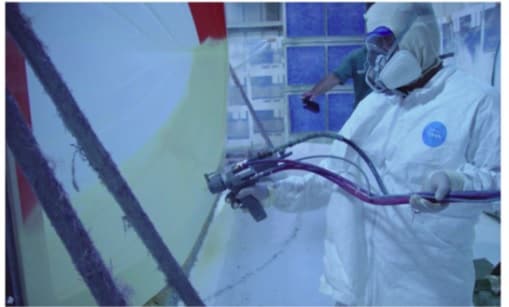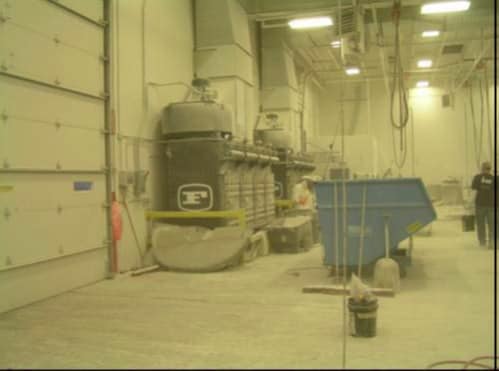Engineering Controls Database
Styrene Exposure: Fiberglass-reinforced Plastic Boat Manufacturing
| Styrene is an important component in the manufacture of fiberglass reinforced plastic (FRP) boats. Vapors from the application and curing process used to make FRP boats may pose an inhalation exposure hazard for workers near the process. According to the 2004 Statistics of U.S. Businesses, 51,409 workers were employed in the boat manufacturing industry (most of which were involved in FRP manufacturing), with 26,633 in firms of 500 employees or less. | |
| Workers exposed to styrene for short periods of time through inhalation may exhibit irritation of the eyes and mucous membranes, and gastrointestinal effects [40 CFR 63 (2000)]. Styrene inhalation over longer periods of time may cause central nervous system effects including headache, fatigue, weakness, and depression. Exposure may also damage peripheral nerves and cause changes to the kidneys and blood. Several studies have shown that styrene exposures were linked to central and peripheral neurologic [Fung et al. 1999], optic [Triebig et al. 2001], and irritant [Minamoto et al. 2002] effects when occupational exposures to styrene vapors in air were greater than 50 parts per million (ppm). Styrene has been shown to be a potent ototoxicant by itself, and can have a synergistic effect when presented together with noise or ethanol [Sliwinska-Kowalska et al. 2003]. Styrene exposure can cause permanent and progressive damage to the auditory system in rats even after exposure has ceased [Campo et al. 2001]. | |
|
In the early 1980s, researchers from the National Institute for Occupational Safety and Health (NIOSH) conducted an engineering control technology assessment of styrene exposures in the FRP boat manufacturing industry [NIOSH 1983]. The study focused mainly on ventilation systems and work practices used in the open molding production of large FRP boats and yachts. In 2004, NIOSH researchers began a follow-up assessment to evaluate worker exposures from new processes that have been introduced since the previous NIOSH study. Several of the technologies include processes that use low styrene resins, non-atomizing spray equipment, pressure driven rollers, closed molding, and improved general and exhaust ventilation. Where do exposures occur: Workers may be exposed to styrene during a number of different processes during the manufacture of FRP boats. The following is an example of the process at one plant (306-11a) NIOSH evaluated where the FRP components are built from the outside of the boat components to the inside. In this plant, the first step involved the application of the gelcoat, the material that provides the color and appearance of the outer surface of the boat. Prior to each molding operation, the molds were cleaned and then a release agent was sprayed which contained a pigmented gel coat along with an initiator that formed the outside surface of the boat. The gelcoat was sprayed onto the open mold within an enclosed and ventilated booth. After gelcoating, the molds were moved to one of three laminating areas: decks, hulls, or small parts. In each of the laminating areas, a worker (gunner) applied resin and chopped glass fiber to the mold with a chopper gun. The resins are mixed with an initiator to start a cross-linking reaction between the resin molecules. Other workers (rollers) smoothed and compressed the glass and resin using a variety of rollers and flexible blades to saturate the fibrous glass with resin and to remove entrapped air. As a result, the resin hardens to form a rigid fiber-reinforced matrix. Depending on the part, additional layers of glass fiber and resin are added and rolled out until the desired thickness is obtained. In addition, at various stages, glass fiber mats, wood panels, and metal plates were added for additional strength.   |
|
| 306-11A; 306-11B; 306-13A; 306-14B; 306-15A; 306-16A; 306-17A; 306-18A; 306-19A; 306-19B; | |
|
Campo P, Lataye R, Loquet G, Bonnet P [2001]. Styrene-induced hearing loss: a membrane insult. Hear Res 154(1-2): 170-180. Fung F, Clark RF [1999]. Styrene-induced peripheral neuropathy. J Toxicol-Clin Toxicol 37(1): 91-97. Minamoto K, Nagano M, Inaoka T, Futatsuka M [2002]. Occupational dermatoses among fibreglass-reinforced plastics factory workers. Contact Derma 46(6): 339-347. NIOSH [1983]. NIOSH criteria for a recommended standard: occupational exposure to styrene. Cincinnati, OH: U.S. Department of Health and Human Services, Public Health Service, Centers for Disease Control, National Institute for Occupational Safety and Health, DHHS (NIOSH) Publication No. 83-119. Sliwinska-Kowalska M, Zamyslowska-Smytke E, Szymezak W, Kotylo P, Fiszer M, Wesolowski W, Pawlaczyk-Luszczynska M [2003]. Ototoxic effects of occupational exposure to styrene and co-exposure to styrene and noise. J Occup Environ Med 45(1): 15-24. Triebig G, Stark T, Ihrig A, Dietz MC [2001]. Intervention study on acquired color vision deficiencies in styrene-exposed workers. J Occup Environ Med 43(5): 494-500. |
|
| 326199 | |
|
fiberglass fiberglass plastic boat manufacturing plastic boat manufacturing styrene styrene |
|
|
For gelcoaters work practices, nozzle design, and spraying techniques combined with a well-designed ventilated booth helped prevent high personal breathing zone concentrations at one plant (306-14b). Also at this plant, closed molding controlled occupational exposures to styrene more effectively than traditional open molding methods for lamination of small parts. The closed molding process took place in a sealed environment and was not located near any open molding processes. Evaluations of closed molding at other boat manufacturing facilities have resulted in much higher exposures when the processes were located near open molding. There were a wide variety of engineering controls used at the different plants during the NIOSH study. In general, the study indicates that the evaluated controls were effective in controlling styrene vapor under the evaluated conditions. Maintenance of engineering controls needs to be performed on a regular basis to ensure the controls are functioning properly. |
